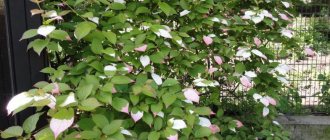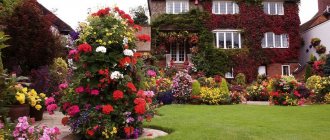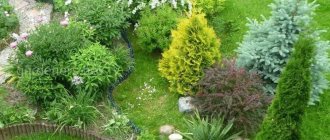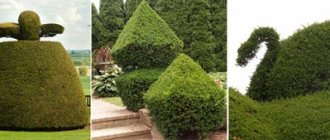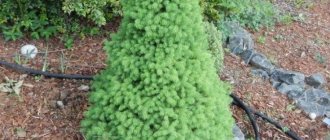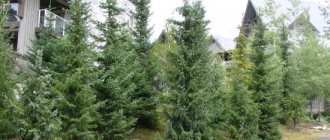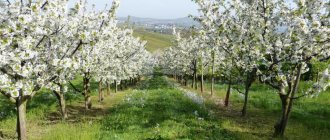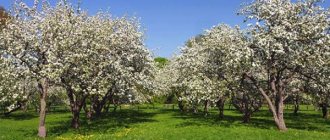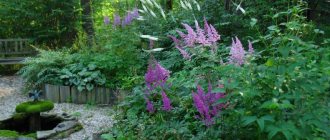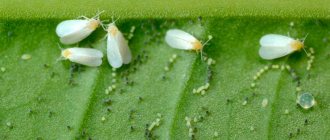Design compositions featuring coniferous plants are impressive: alpine slides, rockeries, Japanese-style gardens, multifaceted mixborders, spectacular tapeworms, evergreen hedges, rich in color and forest spirit. Many summer residents strive to follow fashion trends, introducing coniferous trees and shrubs into their plots in addition to the usual decorative perennials. But not everyone, due to the lack of necessary space, certain knowledge, financial and sometimes physical capabilities, can decide on a grandiose floristic project. You can make a small flowerbed with conifers on six acres, especially since there are many low-growing species and varieties.
Thanks to coniferous plants, the garden plot becomes elegant, solemn, stylish and self-sufficient
Botanical certificate
Experts categorically object to the current situation, when coniferous plants, due to widespread habit, are called “conifers.” According to the botanical classification, they are representatives of different classes that are included in the Gymnosperms department.
So, the conifers include the well-known spruce, pine, fir, larch, juniper, cypress, thuja, yew, etc. , and among the Gnetaceae (Temenaceae) the order Ephedra stands out, the prominent representative of which is ephedra or double-spike conifer, colloquially also called “Kuzmicheva grass” and “Steppe raspberry”.
More than 60 species of ephedra are known, which grow in southern Europe, Western Siberia, Asia, Kazakhstan, China on the slopes of hills, mountains, and among stones. In many regions the plant has conservation status. The fact is that many types of ephedra contain the alkaloid ephedrine, which has an effect similar to adrenaline. The drugs methamphetamine and ephedrone are produced from ephedrine.
Since 2004, the plant has been included in the list of those prohibited by the Government of the Russian Federation for cultivation in large and especially large sizes. In the case of ephedra, a large fine will be issued if more than 10 specimens are found on the site. But this beautiful shrub is an excellent component of the alpine hill; its fruits are edible both fresh and processed (jam, preserves), and contain only residual traces of ephedrine.
The juicy cone berries are similar to multi-drupe raspberries - hence the name “Steppe raspberry”. The plant is not a conifer
The plant has been known since ancient times. Tribes and nationalities inhabiting the areas where conifers grow used them for ritual ceremonies.
In China, Chinese ephedra, called “yellow hemp,” was used for medicinal purposes.
In Russia, at the end of the 19th century, a peasant from the Samara province, Fyodor Kuzmich Mukhovnikov, treated rheumatism, digestive disorders, and bronchopulmonary diseases with ephedra decoctions. In his honor, the plant began to be called “Kuzmicheva grass” among the people.
“Ephedra two-spikelet” is not at all similar to representatives of Conifers. Gray-green shoots extend from the shortened woody stem, reaching a height of 30-50 cm. The leaves are reduced. The fruits are juicy cone berries (false berries), which birds feed on, which contributes to the spread of the species.
Winter-hardy yew varieties
Yew is an evergreen plant. There are dwarf and shrub varieties. There are also varieties that grow into large and powerful trees.
Intermediate yew
It does not have resin and, as a result, does not emit an odor. Instead of cones, berry clusters are formed. The intermediate yew bears fruit annually.
Intermediate yew is a low-winter-hardy plant, but it easily tolerates drought.
Photo: Low-winter-hardy intermediate yew.
Advantages and basic tenets of a mixed flower bed
Evergreens are beautiful all year round and require little care. The flower beds in which they grow are called “beds for the lazy” - after all, the main effort has to be spent at the creation stage, when you need to think about the location, composition and layout, purchase seedlings, stones, mulch, and plant correctly. Further care is minimal.
Conifers are also very useful: they secrete phytoncides - volatile substances that can suppress the development of viruses, bacteria, and pathogenic fungi.
Spruce, thuja, and cypress trees planted along the boundaries of the site have a unique resinous aroma and reliably protect from wind, dust, and pollution.
Creating a flower garden with various types of coniferous trees and shrubs requires compliance with certain rules :
- A game of contrasts - neighboring plants should contrast in size, shape, color.
- Priority to compact, low-growing varieties.
- Mandatory consideration of the final size and characteristics of an adult plant.
- The principle of layering - tall forms are given a place in the back row, on the edge or center, in front of them are placed plants of the second tier and low-growing ground cover plants.
- Careful selection of the entire composition - you need to think through the combination and arrangement of different types of conifers, ornamental shrubs, flowering and herbaceous perennials, and annual crops.
- Attention to design - stones are considered, if not mandatory, then a desirable element; a flower bed with conifers looks good on a well-groomed lawn.
- Decorating/mulching the soil surface between plants.
The principles of tiering and contrast do not separate, but unite the participants of a mixed flower bed into a harmonious ensemble
Winter-hardy varieties of juniper
Juniper is a sun-sensitive shrub, especially in spring. It requires more attention when compared with thuja, for example. Thus, some varieties of juniper must be protected from the sun even in adulthood.
Externally, juniper resembles cypress.
| It has an unusual property: it makes the atmosphere around much cleaner. One hectare of plant can purify almost 30 kg of phytoncides. |
Juniper horizontal
Juniperus horizontalis is an exception in the family. He calmly tolerates the sun's rays, unlike his brothers. There will be fewer problems with him. The bush spreads in a beautiful carpet, becoming an unusual decorative element.
Photo: Horizontal juniper will help in landscaping.
Juniper Holger
That rare species of juniper that is unpretentious in care. Suitable even for a novice gardener. Holger is a low-growing plant, no more than a meter in height.
In spring, its needles shimmer gold. The fruits are small cones that resemble berries.
Photo: Holger fruits are small cones that look like berries.
Which plants to choose
Various types and varieties of conifers are widely used in landscape design. We will list only some representatives from this list.
Thujas are unpretentious and frost-resistant. Mixed compositions usually include pyramidal varieties: “Smaragd”, “Brabant”, “Columna” and spherical ones: “Danika”, “Globoza”, “Golden Globe”, “Teddy”.
For more information about popular varieties of thuja, the features of their planting and subsequent care, read the article on our website.
Junipers are well suited for forming all three tiers. High verticality is created by “Sentinel”, “Arnold”, “Compress”, “Hibernica”. For the second tier, shrub varieties of ordinary, Cossack, medium, and scaly are chosen. Horizontal and Siberian grow beautifully as ground covers.
Among the horizontal junipers there are options with yellow (“Golden Carpet”, “Lime Glow”), blue (“Blue Chip”, “Jade River”) and color-changing (“Andorra Compact”) needles
Among the pine trees , black “Pyramidalis” and narrow-columnar “Fastigiata” are considered optimal for creating a background, and low-growing mountain pines for the foreground: “Pug”, “Gnome”, “Benjamin”.
Spruces are also planted as main accents. In nature, they reach enormous sizes - up to 30 m. Low, dwarf varieties are chosen to decorate garden plots and summer cottages. “Iseli”, “Fastigiata”, “Kupressina” make up the upper tier, varieties with a blue tint of needles “Glauka Globoza”, “Sanders Blue”, as well as “Konika”, “Belobok” with an original color or “Alberta Globe” similar to thick bush - medium. Solitaire spruces and pines often play the role of New Year trees; they are convenient to decorate in winter right in the garden.
The fir is notable for its cones with stunning colors ranging from pink to deep purple. Large-sized “Pyramidalis” and “Compacta” go well with dwarfs: “Nana”, “Tundra”, “Piccolo”, “Silver Star”.
Cypress trees are beautiful, but demanding on growing conditions. The most popular among domestic gardeners is the Lawson cypress.
Also of interest is hemlock , which has hanging branches with soft needles and small, fine-scaled cones. Its dwarf varieties look great in mixborders, rockeries, and alpine slides.
A special effect is created by weeping forms of hemlock, for example, “Pendula”, “Young Con”, “Mall”, “Cols Prospect”
If you plan to include other ornamental shrubs or subshrubs in a composition with conifers, then pay attention to barberry, forsythia, heather, Erica, boxwood, spirea, and hydrangea. They will highlight and highlight each other's beauty all year round, like plants in a mixed forest.
As neighbors of the middle and lower tier, you should definitely plant herbaceous perennials : ferns, sedges, cereals, hosts, astilbes, alliums. For a flower bed with conifers and flowers , daylilies, irises, phlox, roses are perfect; as ground cover forms it will be organically complemented by: subulate phlox, thyme, heuchera, bryozoan, creeping tenacious, sedum, coin loosestrife.
Winter-hardy varieties of spruce
Spruce pleases with a variety of species; there are trees for every taste. With green and blue needles, with colored cones, of different shapes and sizes.
| However, if you need to choose a variety carefully, there are picky plants. |
Norway spruce Nidiformis
Spruce nidiformis always pleases with good growth, and young green shoots adorn the tree. The crown has a prominent nest shape. Cones appear after four years of the plant's life, decorating the spruce.
Nidiformis will not be able to tolerate soil that is too wet; the plant should not be overwatered. Drainage will help solve the problem; it will regulate the amount of moisture.
Photo: Spruce Nidiformis is distinguished by its nest-shaped crown.
Prickly spruce Glauka Globoza
The unpretentious and compact variety Glauca Globoza came to us from the North American states. The spruce tree has blue needles and bright crimson cones. It can become the main decoration of the garden.
Glauca globoza needs to be watered twice a week, in dry weather. Sanitary pruning is also required. But spruce easily overwinters and is not afraid of sunlight.
Photo: Glauka Globoza stands out with its blue needles.
Norway spruce Akrokona
Common spruce Akrokona is especially good in spring. During this period, young growths turn into red cones, and vegetative shoots become rich green.
The maximum height of the tree is 2-3 meters, but it grows slowly at 10 cm per year. A young plant needs to be moistened and loosened. With age it becomes less demanding.
Photo: Red cones of the Akrokona spruce.
Prickly spruce Belobok
Belobok gets its name from the creamy white growths that appear for two weeks in the spring. Does not require decorative crown formation. The procedure can even cripple the tree. The top of his head is not recovering.
Photo: White growths of Belobok spruce.
Serbian spruce
The crown of Serbian spruce is cone-shaped and pointed. It easily tolerates even the most severe frosts. Grows up to 30-40 meters. Lives long: from 200 to 800 years.
There is no need to take special care of the spruce. The main thing is to avoid stagnation of water at the roots. May periodically lose fragments.
Photo: Serbian spruce easily tolerates frost.
Canadian spruce Konica
Canadian spruce Konica is not winter hardy and is sensitive to the sun. May receive burns incompatible with life.
The crown of the spruce is cone-shaped. A young seedling may not have an ideal shape, but with each new year of the tree’s life, the outline will become more and more noticeable.
Photo: Canadian spruce Konica requires careful care.
Spruce Inversa
Spruce inverta is a weeping variety; its central shoot must be lifted and fixed. Otherwise it will be a creeping pillow. In an adult tree, the branches hang down to the ground, resembling a willow in shape.
Advantages of the variety: unpretentiousness, frost resistance and unusual appearance.
Photo: The central shoot of the Inversa spruce needs to be fixed.
Photos and diagrams
The choice of plants, their quantity and combination depends on the size and location of the space that is planned to be allocated for planting ornamental crops on the site.
Mixborders
Mixborder is a complex rectangular flower garden that blooms continuously throughout the season. Its width should not exceed the height of the tallest plant.
Translated from English, mixborder means “mixed border” (mix – “mix” and border – “border”, “border”).
A dwarf pine, two barberry bushes, rock juniper, spirea and hosta planted in a row - although not a full-fledged mixborder, it looks beautiful.
This composition can take place near the fence, against the backdrop of a gazebo, or a bathhouse.
A brighter version of the mixborder - with irises as the central element. The borders of the flowerbed are outlined by cypress and thuja, with spirea bushes and scaly juniper as the border.
Spiraea is notable for its long, abundant flowering and bright foliage color, which goes well with the greenery of the needles
Round and semicircular flower beds
A classic round flower garden can be made in front of the house, in the front garden, or in the garden. The option presented below is collected from shade-tolerant plants.
When planting, it is important to take into account the ability of this form of juniper to grow rapidly horizontally.
A semicircular flower bed with thujas, cypress, spirea and roses is placed in a sunny place or in light partial shade. To maintain the correct shape, a number of spirea bushes are regularly trimmed. You can simplify the task by planting only 3 spirea bushes at an equal distance from each other.
Regular trimming is required to maintain the clear contours of the spirea border.
An interesting option is a round flowerbed made of two parts - the outer hemisphere is formed by 4 spherical thujas, the circle is occupied by juniper, 2 heather bushes and hybrid tea roses
The spherical thuja "Danika" at the age of ten can reach 1 m in diameter and 0.5 m in height. It is unpretentious, tolerates partial shade, but in the sun the needles become brighter and denser.
Corner design
A veranda attached to a house and outbuildings often form corners that remain empty. Such “inconvenient” spaces are best reserved for corner flower beds.
The tile surround and two-color mulching add additional decorativeness to the composition.
Framing garden paths
The path from the gate to the house on one or both sides can be decorated with dwarf junipers and thujas. The alternation of pyramidal and spherical shapes looks good. The spaces between them are usually filled with hostas, heucheras, primroses, chrysanthemum bushes, and bright flowering annuals.
Juniperus 'Blue Star', Heuchera 'Bella Note' and orange daylily form a stylish trio
Protection from diseases
Despite their high resistance to diseases and pests, coniferous plants can still get sick. Moreover, most often the cause of diseases is improper care and unsuitable growing conditions. At the same time, their young shoots may dry out, their needles may turn yellow and fall off.
Yellowing needles are a sign of improper care
The most common causes of such problems are:
- Excessive waterlogging of the soil. In this case, a drainage device will help.
- Drying of roots. Moisture-loving yews and thujas, as well as any young plants that require special attention to watering, suffer from this more often than others.
- Wrong location. The needles turn yellow and fall off in direct sunlight. Therefore, you need to pay attention to the preferences of a particular plant. Most conifers prefer partial shade.
They may also suffer from air pollution from toxic emissions from industrial plants and vehicles.
Conifers are quite resistant to infectious diseases, but can be affected by fungal infections. Mycelium grows into the trunk and interferes with the free movement of water and nutrients.
For reference. The fungal infectious disease of Schutte affects only coniferous plants. Especially weakened, young and recently transplanted. The disease manifests itself in the spring of the next year after infection, so it is impossible to “catch” it in time. It is characterized by yellowing and shedding of needles, the appearance of white, gray or black plaque on the shoots.
Signs of Schutte's disease
Plants are treated with biological products such as Fundazol or Fitosporin, treating them several times with a break of 7-10 days. You can also use a 1% solution of copper sulfate.
Fundazol is a complex remedy for many diseases
Landing rules
The rules for planting plants are not complicated. The planning stage requires serious preparation, since the flower garden will be perennial. It is necessary to clearly consider the planting scheme, using a ready-made one or your own, and determine the location on the site. Depending on whether it will be sunny or shaded, select varieties, purchase seedlings, stones, bedding.
In order to correctly place each of the species, you need to read about them in advance, find out the metric characteristics (height, width) of an adult plant, requirements for environmental conditions and agricultural technology.
If the final width of the thuja is 1 m, then when planting the distance to neighboring plants should be at least 0.5 m on each side
Before starting to dig holes, designers advise placing the purchased seedlings on the ground in accordance with the chosen pattern and assessing the location from different sides.
Many gardeners, believing that conifers grow slowly, plant everything very densely. As they grow, such plantings become denser, lose their decorative properties, and are more likely to suffer from diseases. Don't be afraid of empty spaces in the flowerbed. They can be decorated with large stones, hummocks of sedge, bright clumps of profusely and long-flowering annuals: alyssum, lobelia, thin-leaved marigolds, ever-flowering begonia.
Almost all conifers are undemanding in terms of soil type, fertility, and composition, but it is still better to add peat, sand, and compost when digging. At the bottom of the planting holes (for trees their depth is at least 50 cm) a drainage layer is poured - sand, pebbles, expanded clay. The seedling is carefully transferred from the container and lowered into the hole. Cover with earth, carefully compacting it with your hand so that there are no voids.
Experts recommend buying coniferous seedlings only from ZKS. When transshipping them, it is important to prevent damage to the earthen clod.
The plantings are watered abundantly, the ground is immediately mulched with bark, pebbles, and small cones collected from the pine forest.
Winter-hardy pine varieties
Pine can look harmonious not only in the forest, but also on your site. What will please fans of the lazy garden about pine is that pine will not cause many problems.
| Many varieties of ornamental pines have been developed, which differ not only in size, but also in the color of their needles. |
Species mountain pine
Mountain pine grows from a small seedling and reaches impressive sizes. This is the case when the gardener can spend virtually no time on the plant. The main thing is not to miss the moment when the tree outgrows its designated niche and begins to crowd out other plants. The growth of mountain pine needs to be controlled.
Photo: It is necessary to control the growth of mountain pine.
Mountain pine Carstens Wintergold
Carstens Wintergold is a shrubby mountain pine with a dome-shaped crown. The main feature of the variety is its ability to change the color of the needles. They are green in summer and bright yellow in spring and autumn. It is because of this property that the variety got its name.
Carstens Wintergold is not picky about the soil; he will be comfortable even on sandy soil. It loves moisture, but if you forget to water it, it will not be very indignant.
Photo: Carstens Wintergold acquires yellow needles in autumn.
dwarf pine
Dwarf pine can be planted both in open ground and in pots. This is an unpretentious variety that easily gets along with other plants. Rarely gets sick, dwarf pine is not susceptible to disease.
Young trees have light green needles, while adults have emerald and blue needles.
Photo: Dwarf pine almost never gets sick.
Order – Pine
The pine (coniferous) class includes 6-8 families, 65-70 genera and up to 650 plant species.
It is divided into the following families:
I. Araucariaceae
Araucariaceae - this family includes three genera:
1. Agathis is a large tree with leaf-shaped needles. This genus is distributed in Australia, the islands of the Malay Archipelago, the Philippines, and New Guinea.
2. Araucaria is a tall tree with flat needles. The height can reach up to 90 meters.
Brazilian Araucaria
The cone of the Chilean araucaria weighs up to 1.5 kg.
3. Wollemia is the oldest plant on earth, listed in the Red Book. It was considered extinct until it was discovered by David Noble in Australia in 1994. Its height is 40 meters. Its leaves are flat and up to 8 cm long.
II. Capitothyceae
This family includes three genera:
1. Golovchatotis - grows in Southeast Asia.
2. Amentotaxus is a genus, the peculiarity of which is the presence of dangling earrings in the plant - micro-strobili - cones.
3. Torreya is a genus of small evergreen trees reaching up to 25 m in height.
III. Cypress
Cypress - low creeping or upright growing trees or shrubs. This family is divided into 32 genera and 166 species.
Pine - this family consists of 11 genera and 252 species.
Here are some of the famous genera.
I.I. Shishkin. “At the edge of a pine forest” 1882
Spruce is an evergreen tree (with a beautiful crown) up to 96 meters high.
Cedar is an evergreen plant up to 50 meters high.
Larch - representatives of this family of plants annually shed their needles for the winter. This tree species is the most common on Earth. They can reach a height of up to 50 meters under favorable conditions.
Golden larch
Fir is a genus of plants, the peculiarity of which is that the needles are flat, and their cones, like those of cedars, grow upward and fall apart directly on the trees.
Hemlock - common in Asia and North America.
V. Podocarpaceae
Podocarpaceae - grow in the southern hemisphere - mainly in the Australasian part. But some species are also found in the northern hemisphere.
The family includes 20 genera and up to 200 species of trees.
Sciadopitisaceae - today this genus of plants grows only in Japan. This is a tree with a pyramidal crown. Grows in height up to 40 meters. Has unique needles.
VII. Yew
Yew - Plants of this genus are mostly evergreen, but there are some that lose their leaves. This family includes 6 genera and 31 species.
Austrotaxus is the only species of the yew family that grows in the southern hemisphere.
Yew is a slow growing tree or shrub, up to 10 meters high. Bows and spears were made from its wood.
Yew berry
Conifers are the oldest, most beautiful and decorative class of plants.
How many types of coniferous plants exist, you will learn from this article.
How many types of conifers are there?
In fact, conifers are the oldest on our planet. They are classified into the class Gymnosperms, and they, in turn, are divided into subclasses, families and orders. The most common conifers in our country are yew, pine, and cypress.
The variety of coniferous plants is simply amazing: they include not only “small” plants, but also giant trees, as well as evergreen shrubs. They live for a very long time, some species have already existed for thousands of years on the planet and are the same age as the Egyptian pyramids. Over the course of long evolution, coniferous plant species have been able to develop protective mechanisms that promote reproduction and help plants fight pests and diseases.
The most prominent representatives of conifers are two species:
* mammoth tree
. This truly gigantic tree grows in a Californian national park. It is several thousand years old.
Among the huge diversity of vegetation in the temperate climate zone, conifers occupy a special place. They appeared on the planet many millions of years ago and are one of the main sources of oxygen. Their role in human economic activity is invaluable. Coniferous plants are used in medicine, chemical and cosmetic industries.
Features of reproduction
At home, there are three main methods of reproduction available to an amateur:
- seminal,
- cuttings
- vaccination.
Spruce cuttings do not work well and require pre-treatment. Thus, Serbian, eastern and red spruce, when propagated by untreated summer cuttings, do not take root at all, and black spruce - only 30%.
When treated with a stimulant, Glen spruce cuttings root by 40–45%, but the viability of the resulting seedlings is no more than 20%. And even treated cuttings of Iezian spruce can show a zero level of rooting.
Grafting requires certain skills and is complicated by the long period of growing rootstock seedlings and the low level of grafting of scions. Thus, seed propagation is the most effective and appropriate, especially for species plants.
Seed method
Ripe cones on spruce
The seeds of many common species, in particular Norway spruce, prickly and Sitka spruce, are characterized by the absence of a dormant period. And yet, stratification for 2–3 months increases the germination percentage. To do this, the seeds are placed in a moistened cloth or sand and placed in the refrigerator, kept at a temperature of +1–+4°C.
The cones are removed in late autumn, before they open, spread on paper and dried, after which the seeds are easily shaken out. After stratification, sowing is carried out in a light substrate from a mixture of turf, leaf soil and sand in equal parts. For spring sowing, it is convenient to use cold greenhouses placed in some shade of trees with a loose crown, for example, birch or Japanese maple.
Seed the seeds to a depth of 1–1.5 cm, sprinkle with a layer of sand, and water evenly. Thin, weak shoots appear after 2–5 weeks; they must be shaded from the bright sun. Seedlings grow slowly, not exceeding 3–5 cm in height at the age of one year.
When caring for the plantings, weeds are carefully removed, the soil is kept moderately moist, covered with spruce branches and snow in winter, removing the cover in time in early spring. At the age of 3–4 years, the seedlings are placed in a permanent place.
If sowing is done immediately after collection, use wooden boxes filled with a mixture of three parts peat and one part sand, embedding the seeds to a depth of about 2 cm, and water well. The boxes are buried in the ground, and snow is thrown on top as soon as possible. In the spring, the boxes are removed and placed in greenhouses, awaiting germination. After 1–2 years, the seedlings are planted for growing, and after another two years they are distributed to a permanent place.
